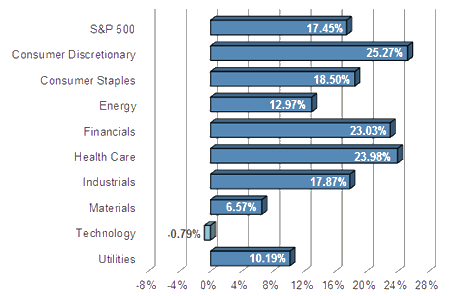Market Commentary by Scott J. Brown, Ph.D., Chief Economist
 Fed Chairman Bernanke said nothing new, but the markets interpreted his comments as “dovish.” In Q&A following a speech on the history of the Fed, Bernanke said that given the high level of joblessness and low inflation, “you can only conclude that a highly accommodative monetary policy is needed.”
Fed Chairman Bernanke said nothing new, but the markets interpreted his comments as “dovish.” In Q&A following a speech on the history of the Fed, Bernanke said that given the high level of joblessness and low inflation, “you can only conclude that a highly accommodative monetary policy is needed.”
He also conceded that “there is some prospective gradual change in the mix of instruments, but that shouldn’t be confused with the overall thrust of policy, which is highly accommodative.” That’s consistent with the Fed beginning to lower the rate of asset purchases later this year and maintaining low short-term interest rates for a long time (well into 2015).
The June 18th-19th FOMC minutes showed that “many members indicated that further improvement in the outlook for the labor market would be required before it would be appropriate to slow the pace of asset purchases.” However, “several members judged that a reduction in asset purchases would likely soon be warranted.”
In the Fed’s detailed Summary of Economic Projections (forecasts were released with the June 19th policy statement, “about half” of senior Fed officials “indicated that it likely would be appropriate to end asset purchases later this year” (that is, to end the program, not just slow the rate of purchases). However, “many other” Fed officials “anticipated that it would likely be appropriate to continue purchases into 2014.”Next week, the mid-month economic reports have some potential to move the markets (if we see any surprises). However, everything will hinge on Bernanke’s monetary policy testimony, or rather, on the market’s interpretation of what the Fed chairman has to say. Bernanke is not expected to say anything new.
We already have the June FOMC minutes, the Fed’s economic projections, and Bernanke’s own words. A reduction in the pace of the Fed’s asset purchases is likely by the end of the year, but tapering is not tightening. A Fed rate increase is still a long way off.
Indices
| Last | Last Week | YTD return % | |
| DJIA | 15460.92 | 14988.55 | 17.99% |
| NASDAQ | 3578.30 | 3443.67 | 18.51% |
| S&P 500 | 1675.02 | 1615.41 | 17.45% |
| MSCI EAFE | 1713.35 | 1645.23 | 6.82% |
| Russell 2000 | 1033.18 | 991.13 | 21.64% |
Consumer Money Rates
| Last | 1-year ago | |
| Prime Rate | 3.25 | 3.25 |
| Fed Funds | 0.10 | 0.18 |
| 30-year mortgage | 4.51 | 3.56 |
Currencies
| Last | 1-year ago | |
| Dollars per British Pound | 1.510 | 1.553 |
| Dollars per Euro | 1.302 | 1.225 |
| Japanese Yen per Dollar | 99.130 | 79.640 |
| Canadian Dollars per Dollar | 1.039 | 1.019 |
| Mexican Peso per Dollar | 12.870 | 13.331 |
Commodities
| Last | 1-year ago | |
| Crude Oil | 104.91 | 85.81 |
| Gold | 1281.43 | 1579.73 |
Bond Rates
| Last | 1-month ago | |
| 2-year treasury | 0.33 | 0.28 |
| 10-year treasury | 2.55 | 2.15 |
| 10-year municipal (TEY) | 4.63 | 3.57 |
Treasury Yield Curve – 07/12/2013
S&P Sector Performance (YTD) – 07/12/2013
Economic Calendar
| July 15th |
— |
Retail Sales (June) |
| July 16th |
— |
Consumer Price Index (June) Industrial Production (June) Homebuilder Sentiment (July) |
| July 17th |
— |
Building Permits, Housing Starts (June) Bernanke Monetary Policy Testimony (House) Fed Beige Book |
| July 18th |
— |
Jobless Claims (week ending July 13th) Bernanke Monetary Policy Testimony (Senate) Philadelphia Fed Index (July) Leading Economic Indicators (June) |
| July 31st |
— |
Real GDP (advance 2Q13 + comprehensive revisions) FOMC Policy Decision (no press briefing) |
| August 2nd |
— |
Employment Report (July) |
Important Disclosures
US government bonds and treasury bills are guaranteed by the US government and, if held to maturity, offer a fixed rate of return and guaranteed principal value. US government bonds are issued and guaranteed as to the timely payment of principal and interest by the federal government. Treasury bills are certificates reflecting short-term (less than one year) obligations of the US government.
Commodities trading is generally considered speculative because of the significant potential for investment loss. Markets for commodities are likely to be volatile and there may be sharp price fluctuations even during periods when prices overall are rising. Specific sector investing can be subject to different and greater risks than more diversified investments.
Tax Equiv Muni yields (TEY) assume a 35% tax rate on triple-A rated, tax-exempt insured revenue bonds.
![]() Material prepared by Raymond James for use by its financial advisors.
Material prepared by Raymond James for use by its financial advisors.
The information contained herein has been obtained from sources considered reliable, but we do not guarantee that the foregoing material is accurate or complete. Data source: Bloomberg, as of close of business July 11th, 2013.
©2013 Raymond James Financial Services, Inc. member FINRA / SIPC.





